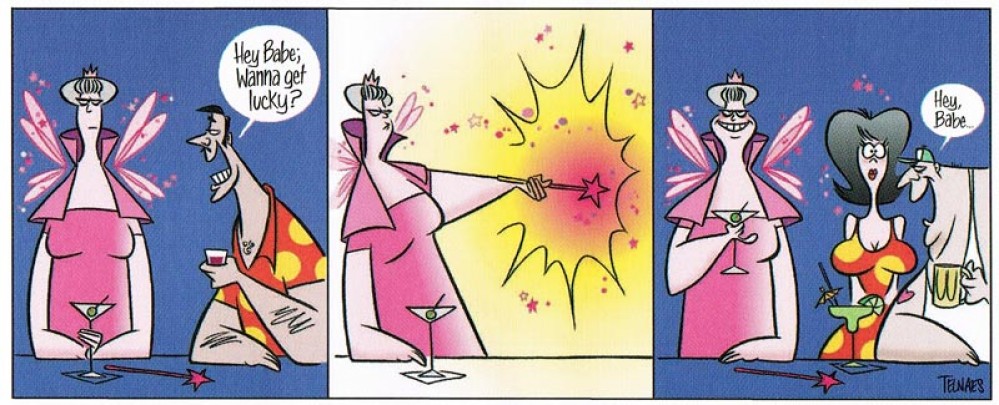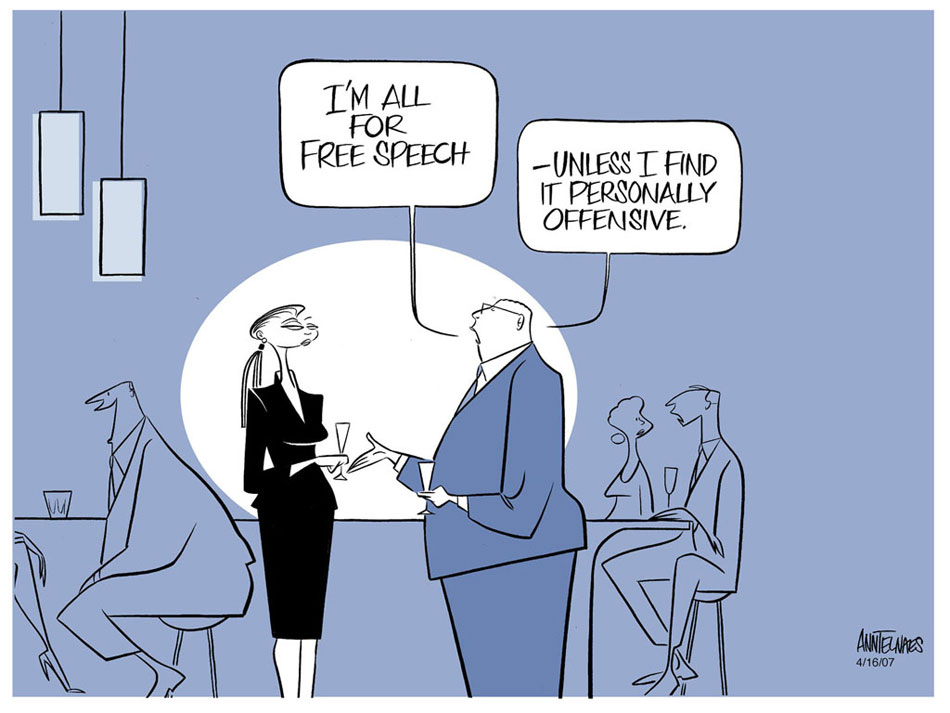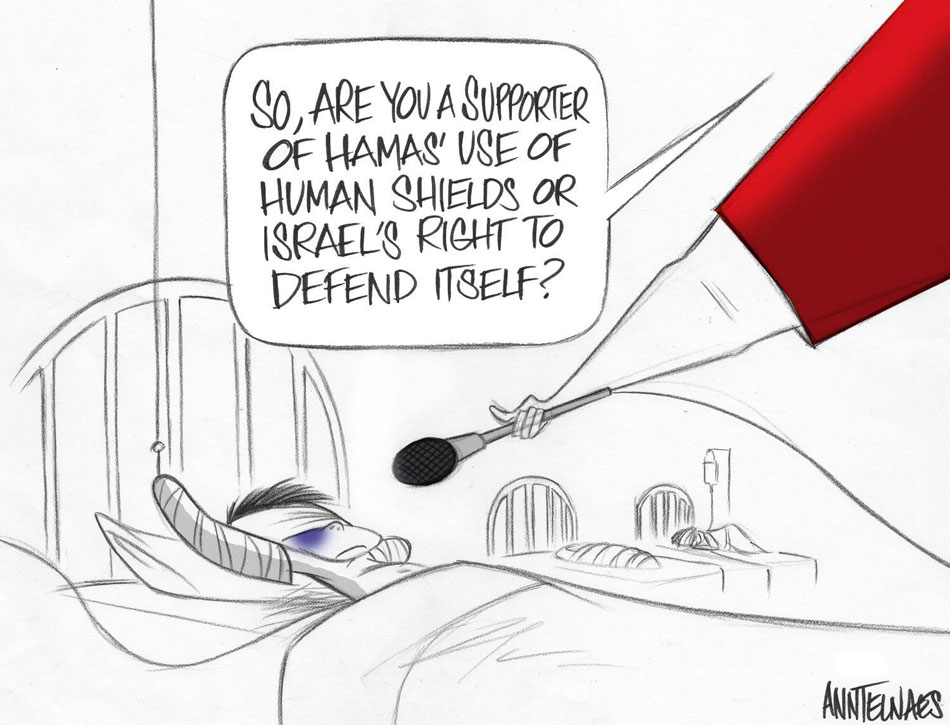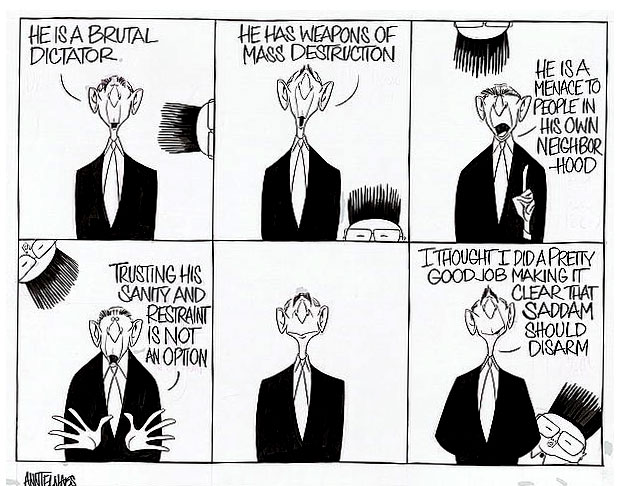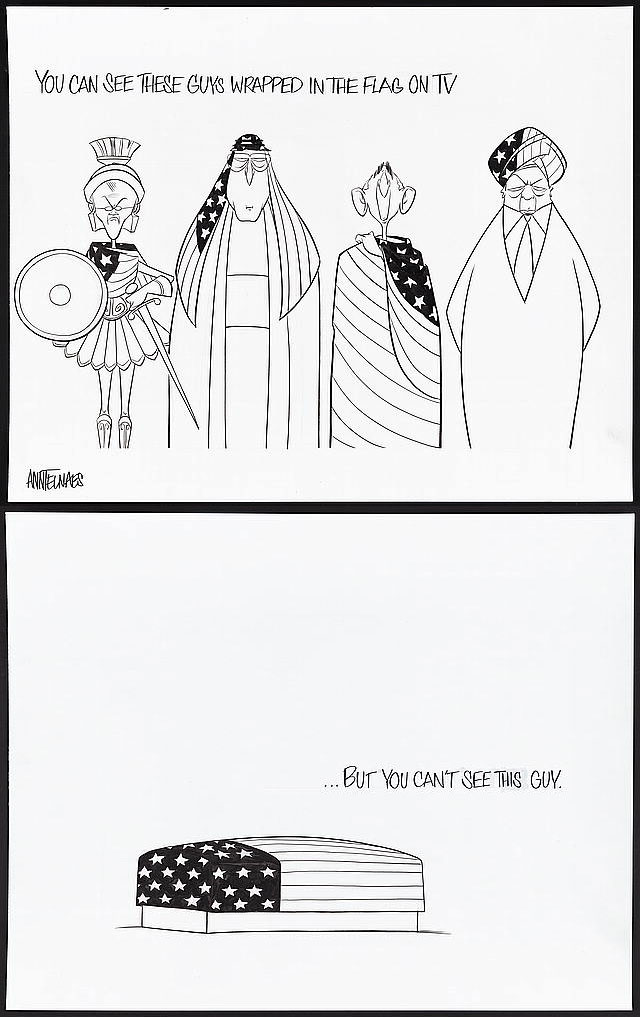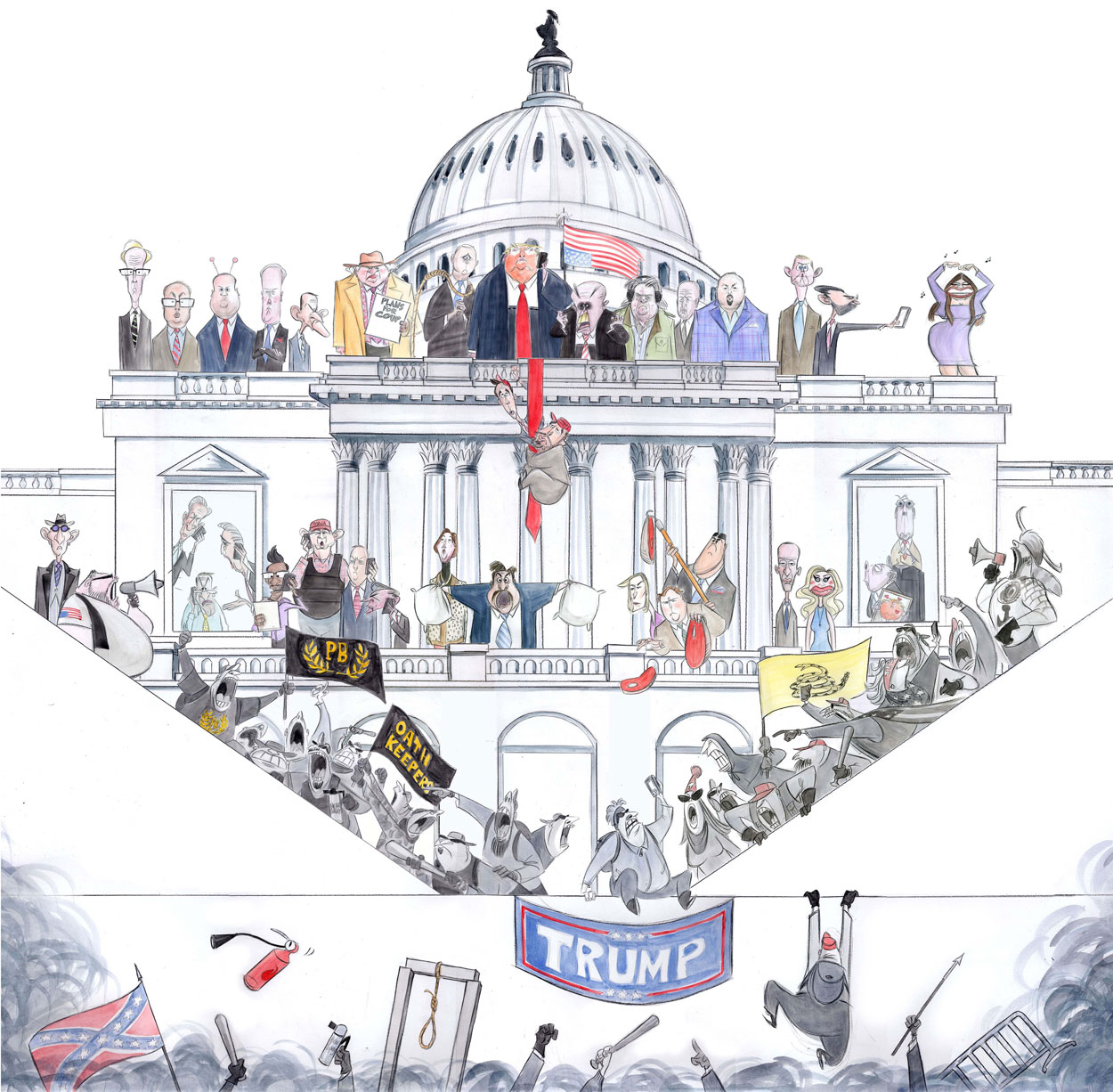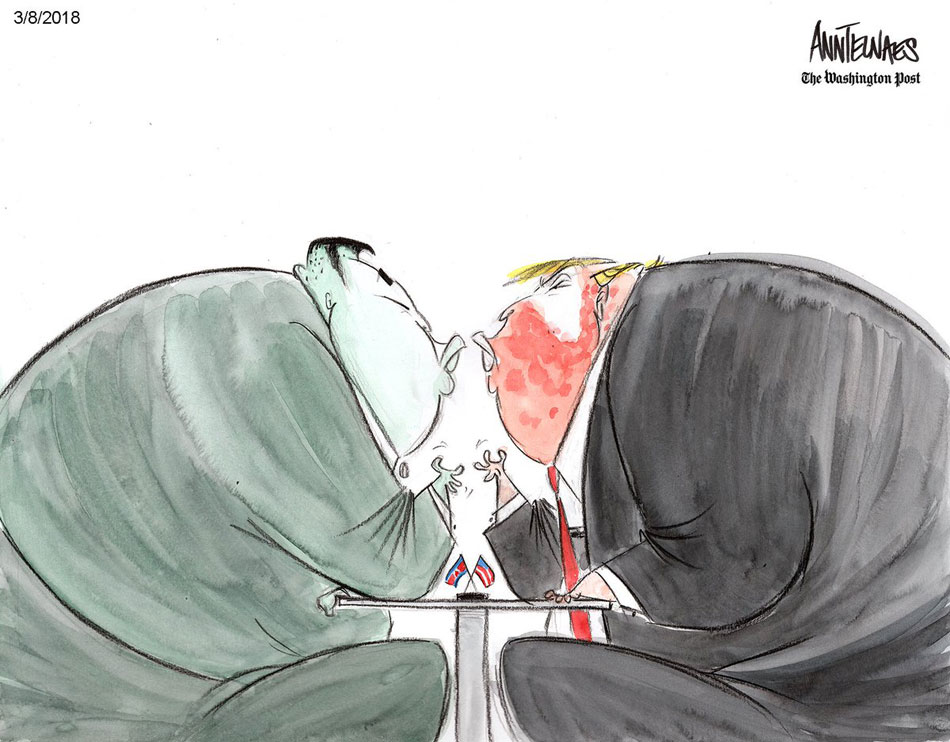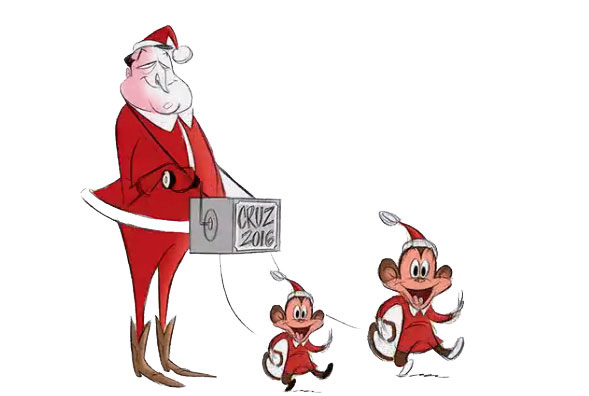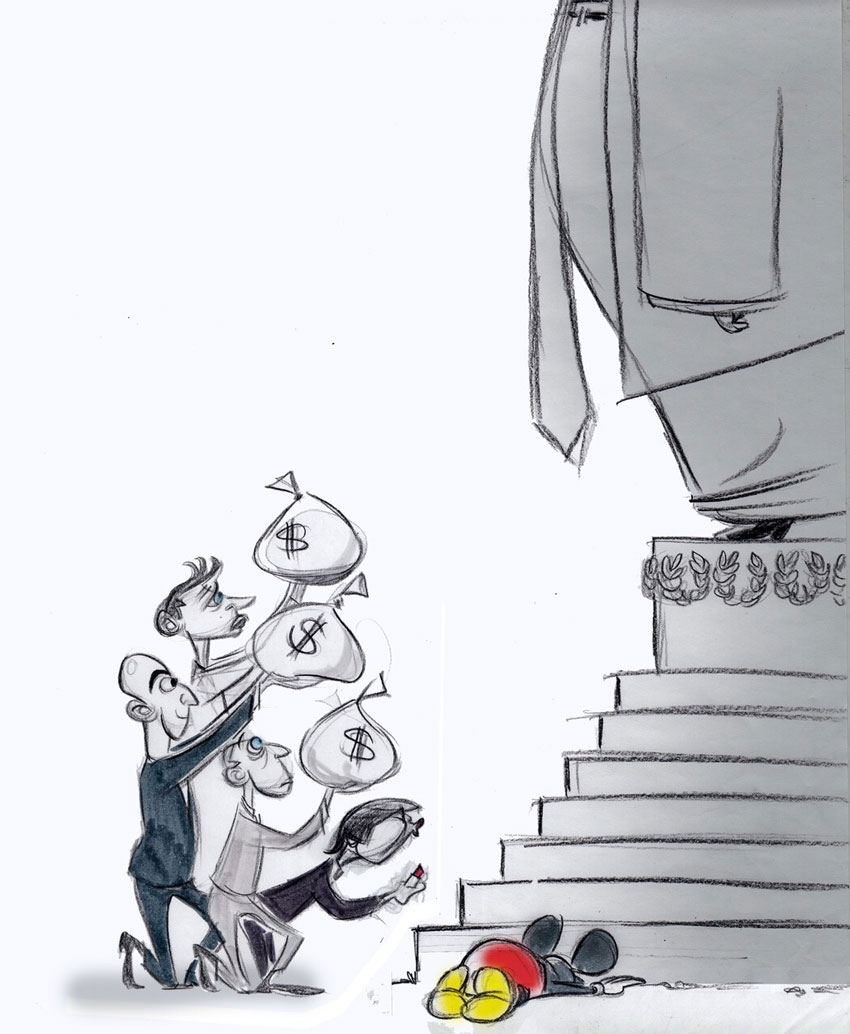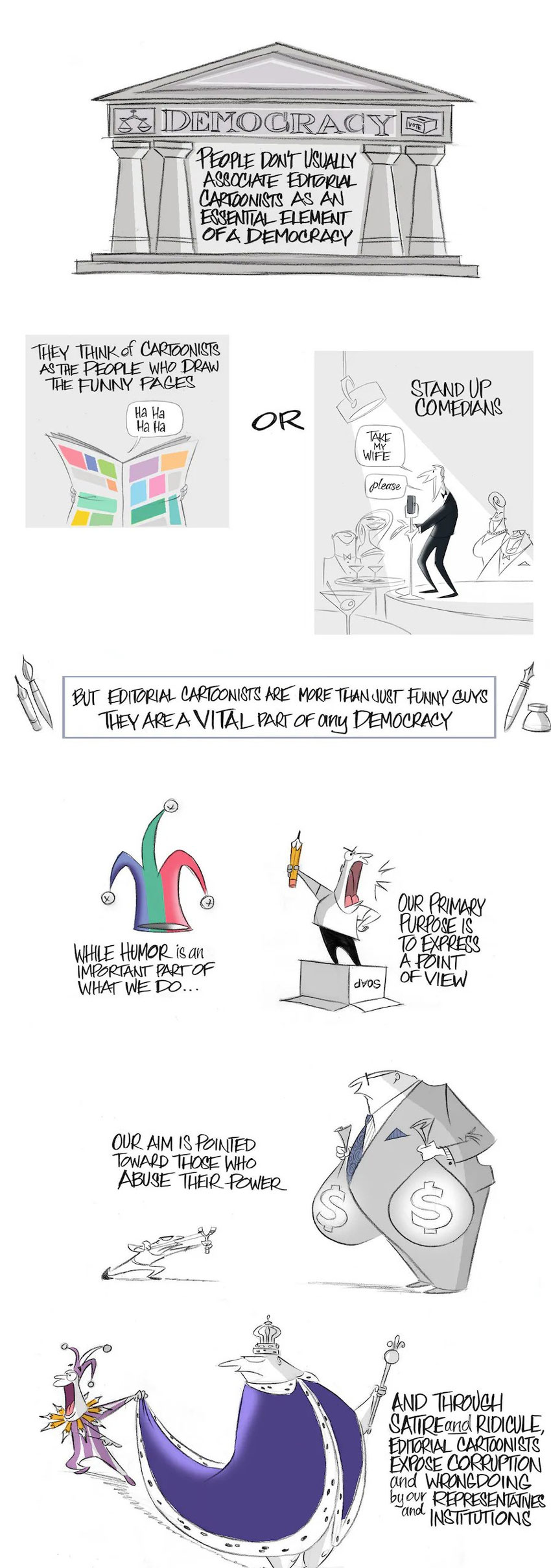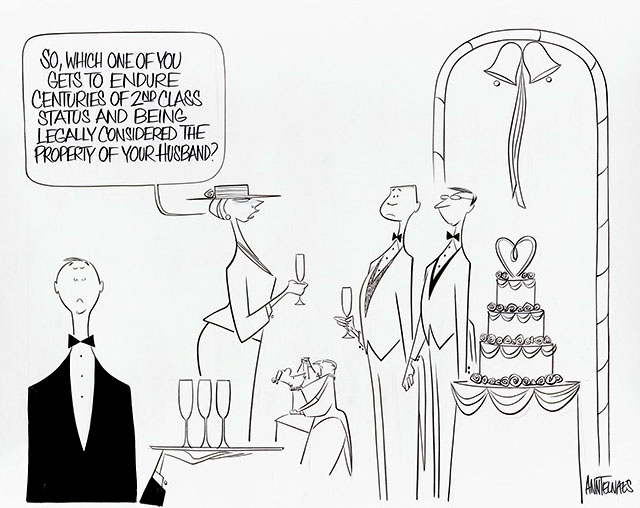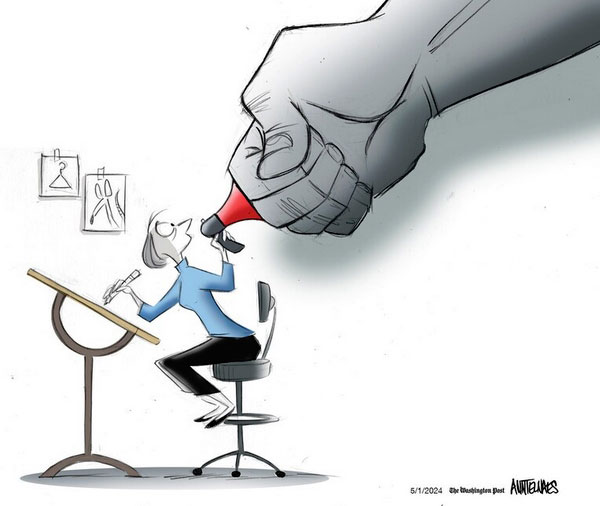Ann Telnaes cartoon of 16 April 2007.
Ann Telnaes is an American animator and editorial cartoonist, known for her biting political cartoons. She is the only female three-time Pulitzer Prize winner. Between 2000 and 2005, Telnaes was one of six female cartoonists who contributed to the socially conscious and feminist gag comic 'Six Chix'.
Early life and career
Ann Carolyn Telnaes was born in 1960 in Stockholm, Sweden, as the daughter of Norwegian-German parents. Her father was an IBM executive, a job that required him to move around a lot. By 1970, the Telnaes family moved to the United States, where she was naturalized as a U.S. citizen three years later. She enjoyed drawing from a young age. Among her main graphic influences are painter Henri de Toulouse-Lautrec, sculptor Alexander Calder, illustrators Alice & Martin Provensen, Ronald Searle, Sempé, Norman Thelwell, editorial cartoonists Jules Feiffer, Robert Osborn, Pat Oliphant, Gerald Scarfe, Disney animators Mary Blair, Marc Davis, Ward Kimball, Tom Oreb, Walt Peregoy and Looney Tunes animator Maurice Noble.
Telnaes studied character animation at the California Institute of the Arts, graduating in 1985. She worked as a show designer for Walt Disney Imagineering. Later she contributed as an animator and layout artist to non-Disney animated films like Jerry Rees' 'The Brave Little Toaster' (1987) and Janice Karman's 'The Chipmunk Adventure' (1987). In those years, Telnaes aspired to stay in the animation industry and had no interest in politics.
Ann Telnaes cartoon of 31 July 2014.
Editorial cartoons
In 1989, while Telnaes was working on a freelance graphic project, she put the TV on as background noise while drawing. As it happened, a news report discussed the massive student demonstrations at the Tiananmen Square in Beijing, China, demanding democracy and more press freedom. The Chinese government bloodily suppressed the protests, then went through extra efforts to pretend it never happened. Telnaes was horrified that a government would slaughter their own civilians. What struck her the most was that the protesters were people around her own age. The Tiananmen Square Massacre made her reconsider her career choices. Telnaes became more socially conscious, reading papers and following the news. In her spare time, she also drew political cartoons, though didn't make them public yet.
Sequential cartoon by Ann Telnaes (3 February 2003). U.S. President George Bush Jr. is fixated on Iraqi president Saddam Hussein, but doesn't notice Kim Jong-Il, dictator of North Korea, who actually has access to weapons of mass destruction.
In 1991, the U.S. Supreme Court judge Clarence Thomas was accused by his former intern Anita Hill of sexual harassment and intimidation. The case led to congressional hearings and divided the general public, but eventually Thomas wasn't prosecuted. Telnaes, who had first-hand experience regarding sexual harassment and intimidation, was outraged. It brought her over a tipping point to finally get her cartoons printed and syndicated, even moving to Washington D.C. in 1993 to be closer to the epicenter of American (and global) politics. There, she also met the legendary cartoonist Herblock a few times. Telnaes' freelance cartoons were soon syndicated by North American/King Features and later Tribune Media Services. They have run in The Austin American-Statesman, The Boston Globe, The Chicago Tribune, The Los Angeles Times, The New York Times, Newsday and, from 2008 to 2025, The Washington Post. Outside of the USA, her cartoons have appeared in The Courrier International and Le Monde. For the non-profit online news service Women's eNews, she has made a weekly drawing, which she dubs her "commentoons".
Ann Telnaes cartoon of 23 October 2003, criticizing the U.S. Wars in Afghanistan and Iraq, depicting U.S. Minister of Defense Donald Rumsfeld, Vice President Dick Cheney, President George Bush Jr. and Attorney General John Ashcroft in patriotic military gear, while the soldiers who get killed overseas don't receive the same media attention.
In her editorial cartoons, Telnaes' past as an animator is still visible. She uses swift, fluid lines, livened up with water colors. Her backgrounds are usually a simple white void, so that nothing distracts from the overall message she wants to convey. Telnaes also makes use of strong expressions, cartoony exaggerations and dynamic movement. In fact, The Washington Post originally hired her to make animated political cartoons for their website, before she also drew more traditional editorial cartoons in its print pages.
Contrary to many other editorial cartoonists, Telnaes is part of an older tradition of critical graphic commentary. Rather than just draw jokes about current events, she wants to strike up debate. Telnaes also distances herself from typical cartoonist clichés, like writing names of politicians, parties or abstract concepts on their bodies or beneath their feet. Readers have to follow the news closely to recognize all her caricatures and understand the allusions. A prime example was her iconic 'Interactive Analysis of the January 6 Insurrection' cartoon (4 January 2022). After Donald Trump was defeated in the 2020 presidential elections, he denied and even contested the election results for months, leading to an escalation on 6 January 2021, when he riled up a huge crowd of his supporters to storm the U.S. Capitol and keep him in power. The event shocked millions of people, and received condemnation from many, including prominent U.S. Republicans. The uprising caused a lot of vandalism and injuries, with a few people getting killed. Telnaes' 'Interactive Analysis' cartoon depicted Trump, various party members and convicted attackers.
'The Insurrectionists' Roll Call', 2022. A "who is who" of who was involved during the Storming of the U.S. Capitol a year earlier (6 January 2021).
While Telnaes covers a wide range of topics and criticizes various ideologies, she frequently focuses on women's issues and discrimination, from Africa, the Middle East and within the Vatican to her home country. On 14 April 2025, Telnaes spoke at the annual Press Freedom Lecture in The Hague, The Netherlands.
Her cartoons have been collected in the books 'Humor's Edge' (Pomegranate Press, 2004) and 'Trump's ABC' (Fantagraphics, 2018). Together with Sara Thaves, she also self-published a book with nothing but cartoons mocking U.S. Vice President Dick Cheney, 'Dick' (2006).
Cartoon by Ann Telnaes, depicting North Korean dictator Kim Jong-Un and U.S. president Donald Trump, 8 March 2018.
Controversy
Like all top political cartoonists, Telnaes' drawings have often caused controversy and outrage. Around Christmas 2015, U.S. politician Ted Cruz released a political TV ad, depicting him and his family having a "heartwarming" Christmas dinner. He was filmed reading his 7 and 5-year old daughters non-existent Christmas stories that attacked U.S. President Barack Obama's administration, with titles like 'How Obamacare Stole Christmas'. One daughter read a carefully scripted line from a book about Hillary Clinton's leaked emails, while asking her father to read from 'The Senator Who Saved Christmas'. On 22 December of that year, Telnaes criticized this exploitation of children's innocence for propaganda purposes by drawing Cruz as an organ grinder, with two small dancing monkeys in Santa Claus costumes. Many readers misunderstood the cartoon and were outraged that Cruz' children "were mocked" and "compared with monkeys". Others deliberately misrepresented the cartoon this way to stir up emotional condemnations. Cruz was also offended, claiming that nobody had the right to "mess with my kids". He went so far as to send a fundraising email under the title 'They attacked my children!', which boiled down to again asking people to vote "for him (...) to fight for you, your family and American families everywhere." On 22 December, The Washington Post eventually removed Telnaes' cartoon from its website.
Cartoon mocking U.S. senator Ted Cruz exploiting his children for a politicized Christmas-themed propaganda TV ad, 22 December 2015.
The Cruz cartoon was a turning point in Telnaes' career. Although she had received harsh criticism and angry readers' letters before, this time she became subject of a veritable smear campaign, not based on what her cartoon actually conveyed, but more on what people thought or were told to believe it was all about. She received death threats, while some commenters stigmatized her on her gender, ranging from calling her a "bitch", a "cunt" to actually hoping she would be "raped to death". Months later (29 June 2016), Telnaes wrote an editorial column about how social media changed the landscape of editorial cartooning, also addressing the Cruz cartoon controversy as a personal example. She pointed out the dangers of mob mentalities on social media and how the original element she was satirizing was never mentioned by her critics. Telnaes: "(...) social media has changed the landscape for editorial cartooning - how it is being used as a tool of intimidation by interest groups and campaigns to try to silence criticism. Through social media they can quickly mobilize their supporters and distribute misinformation, allowing mob mentalities to spread as soon as a cartoon is posted online. The medium is lightning fast and provides the protection of anonymity. Add a news media that seems to value clickbait over presenting context about the editorial cartooning craft and often parrots the inaccurate characterizations the campaigns' supporters spread, and you might as well paint a red bull's eye on the cartoonist's back. (...) The much bigger danger now is the use of social media to intimidate and silence, because it attacks the satirical core of what makes a cartoon an editorial cartoon. If we're being harassed and pressured not to aim our pens critically, we won't be able to call ourselves editorial cartoonists much longer - we won't be able to create anything but mushy, uncontroversial drawings."
The 4 January 2025 cartoon that made Ann Telnaes leave the Washington Post. Jeff Bezos (Amazon), Mark Zuckerberg (Facebook), Sam Altman (OpenAl), Patrick Soon-Shiong (Nantworks) and Mickey Mouse (the Walt Disney Company) worship Donald Trump as an idol.
In 2024, Donald Trump was re-elected as U.S. President. In the days leading up to his inauguration, many billionaires were invited to attend the ceremony, and waited to see their financial investments in Trump's campaign be rewarded with personal enrichment. Telnaes made a cartoon depicting businesspeople Sam Altman (OpenAL), Jeff Bezos (Amazon), Mark Zuckerberg (Facebook), Patrick Soon-Shiong (NantWorks) and Mickey Mouse (symbolizing the Walt Disney Company) worshipping a statue of Trump by bowing down and offering money bags. On 4 January 2025, Telnaes' cartoon was rejected by The Washington Post, a paper not coincidentally owned by Bezos, one of the people criticized in the cartoon. According to Washington Post editor David Shipley the cartoon was simply "redundant", saying he had many "similar cartoons about the same topic" in its pages. Telnaes felt she was being censored and announced that she would leave The Washington Post. She did post her cartoon on her social media accounts, resulting in more widespread international media attention.
Several of her colleagues expressed their solidarity by making their own variations on the contested cartoon. Among them were Pat Bagley, Barry Blitt, Daniel Boris, Steve Brodner, Alexandra Bowman, André Carrilho, Patrick Chappatte, Jason Chatfield, Emma Cook, Liza Donnelly, Clay Jones, Kevin Kallaugher, Michel Kichka, Pierre Kroll, Daniel Murphy, Nancy Ohanian, Ramsés, Tjeerd Royaards, Jen Sorensen, Stellina, Sage Stossel, Kenny Tosh, Wes Tyrell, Nicolas Vadot, Dave Whamond and Zapiro. In a form of poetic justice, a few months later Telnaes won the Pulitzer Prize for Editorial Cartooning for the exact cartoon rejected by the Washington Post.
Six Chix
Between January 2000 and September 2005, Telnaes was one of six female comic artists making the newspaper comic 'Six Chix', syndicated by King Features. The comics focused specifically on current events from a female perspective, and/or satirical situations. Among the other contributors were Isabella Bannerman, Kathryn LeMieux, Rina Piccolo, Stephanie Piro, Margaret Shulock and Carla Ventresca. An initiative of King Features editor-in-chief Jay Kennedy, was titled 'Six Chicks' by Kathryn LeMieux. Every day of the week, a different cartoonist drew an episode, with a rotation system on Sundays where each artist alternates. Telnaes' contributions always appeared on Thursdays.
Before 'Six Chix' was launched, none of the contributing cartoonists had ever met each other. One meeting was organized, but otherwise it was decided to not interact too much, to avoid coming up with the same ideas. Telnaes nevertheless got along well with Margaret Shulock. When Telnaes left 'Six Chix' on 15 March 2006, she passed the pencil for the Thursday contributions to Carla Ventresca.
Scene from a graphic essay by Ann Telnaes, originally created in 2019 for the Bertelsman Foundation, explaining the history, value and necessity of editorial cartoons.
Teaching career
In 2020, Telnaes was a teacher at CalArts, giving the course "Commentary Through Cartoons". In her opinion, it had become increasingly more important to show general audiences the value and necessity of editorial cartoons. She has often encountered people who misunderstood the definition and assumed it boils down to doodlers who make "funny drawings". In interviews and her course, Telnaes explained how an editorial cartoonist is more comparable to an opinion columnist. She also discussed editorial cartoons from past times, especially the ones that by today's standards would be considered racist or sexist. Telnaes insisted that these cartoons shouldn't be hidden away or censored, but instead understood in the context of the time they were created in, before they are challenged.
Support of cartoonists
Telnaes has regularly supported humanitarian causes and fellow cartoonists in trouble. When in 2010 the episodes '200' and '201' of Trey Parker and Matt Stone's animated series 'South Park' depicted the Prophet Muhammad and had to be banned after death threats and media boycotts, she was one of 17 cartoonists signing a petition condemning any silencing of the freedom of expression. In September 2015, Telnaes accepted the CRNI Award for Courage in Cartooning on behalf of the actual winner, Iranian cartoonist Atena Farghadani, who couldn't attend the ceremony since she was imprisoned.
In 2015, when terrorists had killed editors and cartoonists of the French satirical magazine Charlie Hebdo, Telnaes drew a graphic homage in memory of the terrorist victims. In 2017, a campaign to release the imprisoned cartoonist Eaten Fish reached global proportions, and Telnaes rallied for his liberation with a graphic tribute. The same year, Eaten Fish was released. On 15 June 2018, after cartoonist Rob Rogers was fired from the Pittsburgh Post-Gazette, she defended him in an editorial column in The Washington Post.
Between 2016 and 2017, Telnaes was president of the Association of American Editorial Cartoonists. She is also a member of the advisory board of the Freedom Cartoonists Foundation and of the American Newswomen's Club.
21 November 2003 cartoon by Ann Telnaes about same-sex marriages.
Recognition, legacy and influence
In 2001, Ann Telnaes became the second female cartoonist, after Signe Wilkinson, to receive a Pulitzer Prize, namely the Pulitzer Prize for Editorial Cartooning (later renamed 'Pulitzer Prize for Illustrated Reporting and Commentary'). She won the award again under this new title in 2022 and 2025, making her one of a handful of political cartoonists who received a Pulitzer Prize three times. She is also the only female cartoonist to enjoy this honor. Telnaes wasn't the only female cartoonist to receive a Pulitzer Prize in 2025: graphic novelist Tessa Huls also won one, albeit in a different category, for 'Best Memoir or Autobiography'.
Telnaes has also been bestowed with a Population Institute Global Media Award for "Best Editorial Cartoonist" (1996), an Environmental Media Award for "Best Editorial Cartoonist" (1996), National Headliner Award for "Editorial Cartoons" (1997), Maggie Award (2002), Clifford K. and James T. Berryman Award (2003), a Great Immigrants Award (2015), a Reuben Award (2016), an Ewert Karlsson Prize (2021) and a Herblock Prize (2023).
In 2004, Telnaes' cartoons were the subject of a solo exhibition in the Thomas Jefferson Building of the U.S. Library of Congress.
Ann Telnaes has been named an influence by Barbara Dale and Zapiro.
Self-portrait (5 January 2024).


